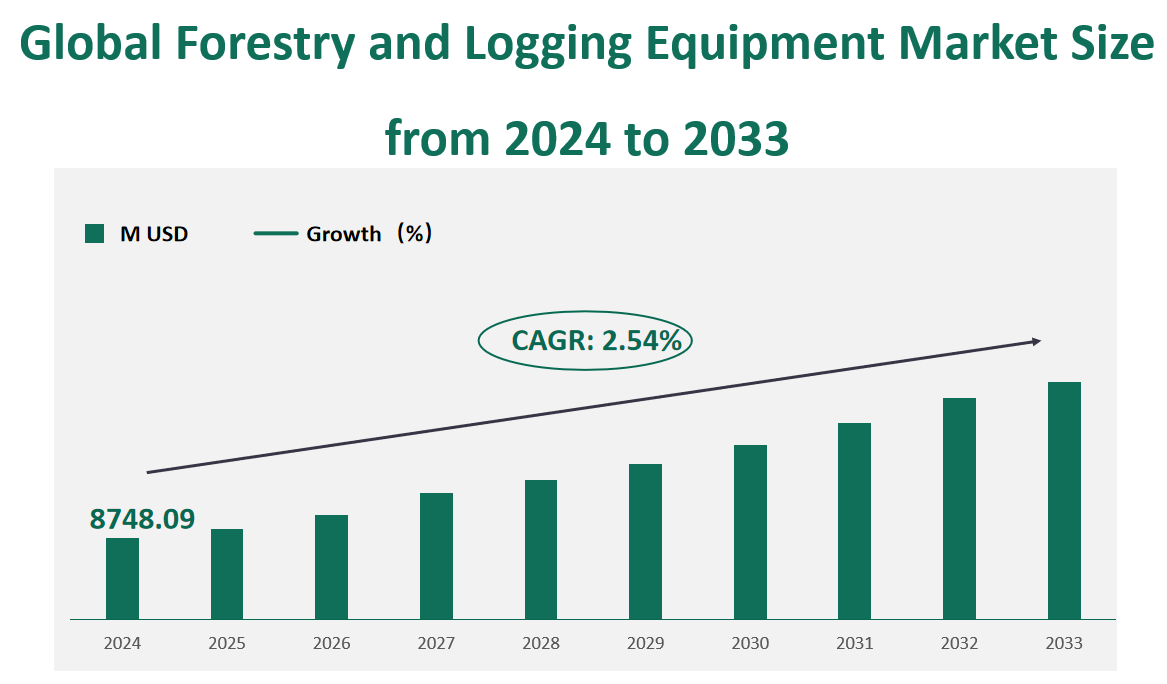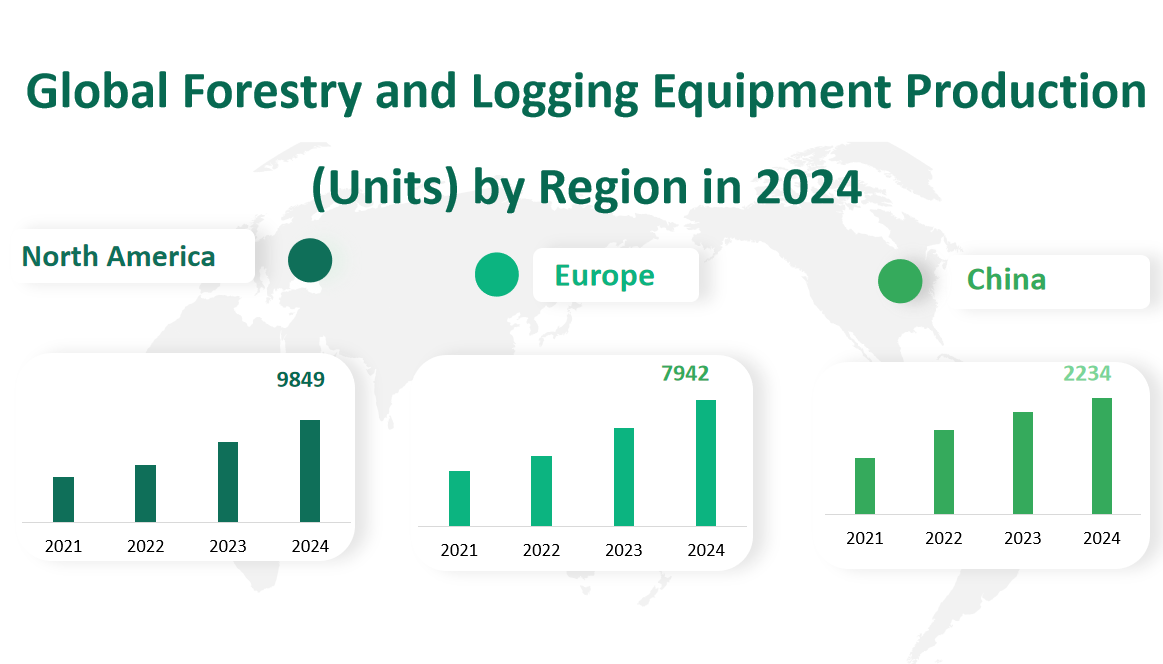1 Global Forestry and Logging Equipment Market Insight Analysis
The global Forestry and Logging Equipment market is expected to witness a CAGR of 2.54% from 2024 to 2033, with a total market value of US$ 8,748.09 million in 2024.
Forestry and Logging Equipment is the equipment used for the production and harvesting of forestry products. Applications for forestry equipment include forestry management and arboriculture. The primary function of logging equipment is to harvest trees, including felling, processing, loading and transportation.
Figure Global Forestry and Logging Equipment Market Size (M USD) and CAGR (2024-2033)

2 Forestry and Logging Equipment Market Growth Drivers and Restraints
The Forestry and Logging Equipment market is subject to multiple growth drivers and restraints that determine its development trajectory. Among the key drivers, the demand for wood products is an important factor. The increasing use of wood in the construction, furniture, and paper industries, coupled with global initiatives to reduce carbon emissions, has led to a surge in wood consumption. The shift toward low-carbon construction and infrastructure development has made wood a key material, replacing high-carbon intensity materials such as steel and concrete. This shift, coupled with urbanization and growing global housing demand, has driven the forestry and logging equipment market.
Another driver is the adoption of advanced equipment in the industry. Technological advancements have led to the development of machinery that can efficiently handle whole trees, improving safety, saving time, and minimizing environmental impact. The integration of computer systems with forestry and logging equipment optimizes performance, reduces energy consumption, and improves wood utilization, further driving market growth.
However, the market faces several restraints. High investment and maintenance costs pose significant challenges. The use of high-quality raw materials such as steel and cast iron and complex drivetrain components increase the cost of forestry and logging equipment. Regular maintenance is required to ensure smooth operation, which increases the overall expenses. Additionally, hydraulic leaks are a common problem that require regular diagnosis to maintain component functionality.
Fluctuations in raw material prices can also impact the market. Volatility in raw material markets driven by factors such as rising energy costs and global events can impact supply chain stability and profitability. Key raw materials for forestry and logging equipment, including motors, steel, bolts, and bearings, are susceptible to these fluctuations, impacted by events such as the military conflict between Russia and Ukraine and the global COVID-19 pandemic.
Strict regulations also act as market discipline. Many countries have implemented logging bans or restrictions on natural forests to promote conservation and prevent deforestation-related disasters. For example, the EU Timber Regulation aims to reduce illegal logging by ensuring that illegal wood or wood products are not sold in the EU. These regulations restrict the supply of wood, negatively impacting the forestry and logging equipment market.
3 Technological Innovations and Mergers in the Forestry and Logging Equipment Market
The forestry and logging equipment industry is going through a period of major transformation, driven by technological innovation and corporate restructuring. Technological advancement is at the forefront of this change, with a focus on developing low-carbon and environmentally friendly equipment. Companies such as John Deere are investing in expanding Kreisel Electric’s production capacity to follow the trend of product electrification and reducing carbon footprint. This strategic move not only increases market share, but also puts the company at the forefront of sustainable forestry practices.
Robotic equipment is another area of innovation that addresses the challenges of labor shortages and poor working conditions in the forestry and logging industries. Robotic equipment can reduce labor costs, improve safety, and increase the level of mechanization, automation and intelligence in forestry operations. For example, robots can be used to effectively control forest pests and diseases, providing large-scale, environmentally friendly and intelligent solutions.
Corporate mergers and acquisitions are also shaping the market landscape. Mergers and acquisitions enable companies to expand their product portfolios, strengthen their market positions, and achieve operational synergies. Mahindra & Mahindra’s acquisition of 100% of Sampo Rosenlew Oy is a typical example of this trend, which has achieved vertical integration and increased control over the supply chain.
Expanding production capacity, such as Kubota’s expansion of its Hirakata plant, is another strategic move to meet high demand, especially in Europe and North America. Such expansions not only meet current demand, but also position the company for future market growth in Asia and other emerging markets.
4 Global Forestry and Logging Equipment Market Size by Type
Afforestation Equipment, which includes machinery for planting and seeding, is projected to generate a revenue of $214.79 million USD in 2024. This segment is crucial for sustainable forestry practices, as it aids in the regeneration of forests and the maintenance of ecological balance.
Tree Felling Equipment, comprising tools like feller bunchers and harvesters, is expected to contribute significantly to the market with a forecasted revenue of $1,870.18 million USD. This type of equipment is essential for the efficient harvesting of timber, ensuring that the process is both swift and safe.
Forest Protection Equipment, which encompasses machinery for fire prevention and monitoring, is forecasted to bring in $479.26 million USD. The importance of this equipment cannot be overstated, as it helps in the preservation of forests against natural disasters and human-induced threats.
Transportation Equipment, including forwarders and skidders, dominates the market with a substantial revenue share. In 2024, it is projected to generate $5,535.78 million USD, accounting for the largest segment of the market. This equipment is vital for the logistics of moving felled trees from the harvesting site to the processing area.
Table Global Forestry and Logging Equipment Market Size and Share by Type in 2024
Type | Market Size (M USD) 2024 | Market Share 2024 |
|---|---|---|
Afforestation Equipment | 214.79 | 2.46% |
Tree Felling Equipment | 1870.18 | 21.38% |
Forest Protection Equipment | 479.26 | 5.48% |
Transportation Equipment | 5535.78 | 63.28% |
Others | 648.09 | 7.41% |
5 Global Forestry and Logging Equipment Market Size by Application
The global Forestry and Logging Equipment market is set to witness a significant consumption pattern across various applications by 2024. This market segmentation is crucial for understanding the demand dynamics and the direction of the industry’s growth. The applications are broadly categorized into personal use, enterprise use, and others, which include government and non-profit organizations related to forest protection.
In 2024, the personal consumption segment is projected to consume 5,908 units, holding a market share of 26.38%. This segment encompasses individual loggers and small-scale forestry operations that require equipment for personal use, highlighting the importance of accessible and affordable forestry machinery for small businesses and independent contractors.
The enterprise application is anticipated to be the most substantial consumer, with an expected consumption of 14,559 units, accounting for a 65.00% market share. This category includes large-scale forestry companies, timber companies, and other corporate entities that demand high-performance equipment for their operations, driving the market for advanced and efficient machinery.
Table Global Forestry and Logging Equipment Market Size and Share by Application in 2024
Application | Consumption (Units) 2024 | Market Share 2024 |
|---|---|---|
Personal | 5908 | 26.38% |
Enterprise | 14559 | 65.00% |
Others | 1932 | 8.63% |
6 Global Forestry and Logging Equipment Market Size by Region
North America, with its vast forestlands and advanced manufacturing sector, is projected to lead in production with an estimated 9,849 units in 2024. The region’s production is underpinned by a strong demand for high-quality forestry and logging equipment, technological innovation, and the presence of major manufacturers like Deere and Caterpillar Inc. The United States, as the largest economy in the region, contributes significantly to this production figure, driven by its expansive forestry sector and continuous investment in advanced equipment.
Europe is expected to produce 7,942 units in 2024, maintaining its position as a significant player in the global market. The region’s production is supported by a well-established manufacturing base, a focus on sustainability, and strict environmental regulations that encourage the adoption of modern forestry practices. Countries like Germany, France, and the United Kingdom contribute to the region’s production with their advanced industrial sectors and commitment to environmental conservation.
China is anticipated to produce 2,234 units in 2024, reflecting the country’s rapid industrial growth and increasing demand for forestry and logging equipment. The Chinese market is driven by large-scale reforestation projects and the need for equipment that can support the country’s ambitious forestry goals. The government’s initiatives to promote sustainable forestry practices have also boosted the demand for advanced equipment.
Japan, with its focus on precision forestry and technologically advanced equipment, is expected to produce 1,578 units in 2024. The country’s production is driven by a combination of domestic demand for high-quality equipment and exports to neighboring countries. Japan’s aging forests and the need for efficient logging practices have led to a focus on developing sophisticated machinery for the forestry sector.
The production figures for 2024 highlight the global distribution of the forestry and logging equipment industry’s manufacturing capabilities. North America and Europe continue to lead with their established industries and technological advancements, while China and Japan demonstrate the growing demand for sophisticated equipment in Asia. Other regions, despite their smaller production numbers, are essential for understanding the global market’s diversity and the potential for future growth. These regions’ production levels reflect their natural resources, industrial development, and the increasing importance of sustainable forestry practices worldwide.
Figure Global Forestry and Logging Equipment Production (Units) by Region in 2024

7 Global Forestry and Logging Equipment Market Analysis by Major Players
7.1 Deere
Company Introduction and Business Overview:
Deere & Company, established in 1837 and headquartered in the USA, is a global leader in the manufacturing of agricultural, construction, and forestry equipment, known for its innovative and high-quality products.
Deere operates on a worldwide scale, offering a comprehensive range of equipment and solutions that cater to the construction, forestry, and agricultural industries. They are committed to delivering products that revolutionize work while maintaining sustainable value for their customers.
Products:
Deere’s forestry and logging equipment portfolio includes a variety of machines such as the 803M Tracked Feller Buncher, known for its peak power of 224 kW (300 hp) and maximum boom reach of 8.49 m (27 ft. 10 in.).
7.2 Caterpillar Inc.
Company Introduction and Business Overview:
Caterpillar Inc., founded in 1925 and based in the USA, is a multinational corporation that specializes in the manufacturing of construction and mining equipment, diesel and natural gas engines, and industrial gas turbines.
Caterpillar Inc. serves a global market with a focus on providing purpose-built solutions to help customers achieve their sustainability goals. They are known for their commitment to delivering reliable and efficient machinery for various applications.
Products:
Caterpillar’s forestry and logging equipment lineup features products like the Forest Machines 538, which boasts a Cat C7.1 engine with a net power of 172 HP and is designed for demanding forestry operations.
7.3 Komatsu Forest
Company Introduction and Business Overview:
Komatsu Forest, established in 1961 and headquartered in Sweden, is a major player in the forestry and logging equipment market, with a presence mainly in Europe, Asia, and North America.
Komatsu Forest AB specializes in the manufacturing of farm machinery and equipment, focusing on forwarders, heads, wheeled harvester’s machines, and spare parts. They are committed to delivering high productivity, reliability, and durability in their products.
Products:
The company’s product portfolio includes advanced machinery like the Komatsu XT430-3 & XT430L-3, which feature modern cabs with state-of-the-art control systems and superior ergonomics, catering to the needs of the sustainable forestry business.

